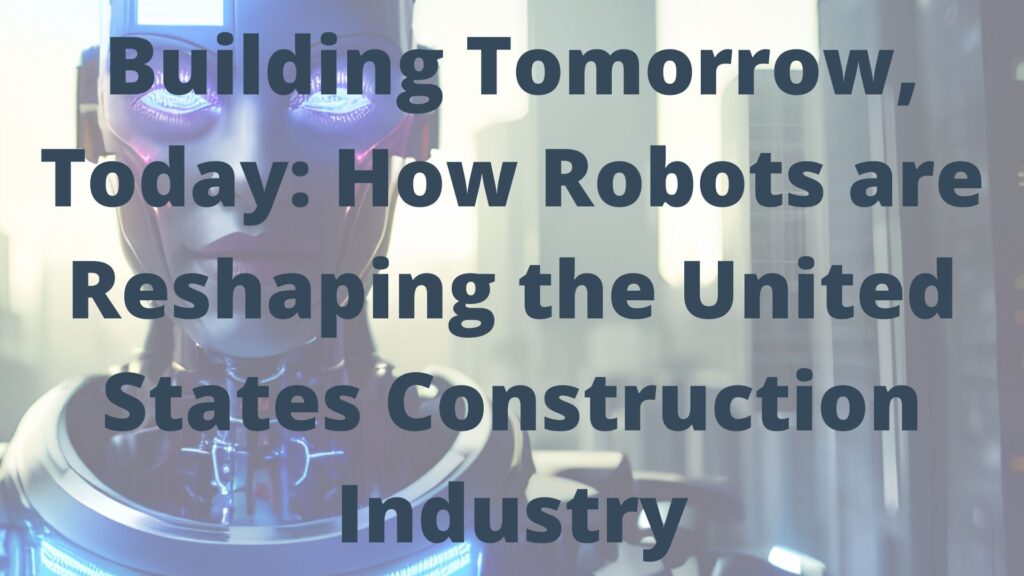
The clang of hammers and the roar of bulldozers have long been the soundtrack of American construction. But a new, more precise and efficient melody is emerging, one composed of whirring motors and articulated arms. Robots are no longer confined to science fiction; they’re actively transforming the way homes and infrastructure are built across the United States, promising faster, safer, and more sustainable construction practices. From the bustling streets of New York to the sun-drenched landscapes of Florida, the construction industry is embracing automation, and the results are truly groundbreaking.
One of the most significant areas where robots are making inroads is in bricklaying and masonry. Companies are deploying robots equipped with advanced vision systems and precise placement capabilities to lay bricks and blocks with unparalleled accuracy and speed. This not only reduces labor costs but also minimizes material waste and improves structural integrity. In New York City, where space is at a premium and construction schedules are often tight, this technology is proving invaluable. Imagine a future where skyscrapers rise faster and more efficiently, thanks to robotic precision. The potential impact on affordable housing and urban development is immense. Similarly, in Florida, where hurricane resilience is paramount, robotic masonry can ensure consistently strong and durable structures, capable of withstanding extreme weather events.
Beyond masonry, robots are also being utilized for tasks such as 3D printing of entire building components, automated welding, and even autonomous earthmoving. 3D printing, in particular, is gaining traction. Companies are experimenting with printing entire homes or sections of buildings using concrete or other sustainable materials. This technology offers the potential to create custom-designed, affordable housing solutions at a fraction of the traditional cost. In Florida, where rapid population growth necessitates efficient construction methods, 3D printing holds significant promise. The ability to quickly and efficiently produce durable, weather-resistant structures is a major advantage in a state prone to hurricanes and flooding.
In New York, the challenges of aging infrastructure are driving innovation. Robots are being used for bridge inspections, tunnel maintenance, and even concrete repair. These autonomous systems can access hard-to-reach areas, providing detailed data and performing repairs with precision. This reduces the risk to human workers and extends the lifespan of critical infrastructure. The use of robotic systems also enables more frequent and detailed inspections, allowing for proactive maintenance and preventing costly failures. In Florida, where coastal erosion and rising sea levels pose significant threats, robots are being deployed for shoreline protection and restoration projects. They can place and manipulate heavy materials with precision, helping to build seawalls and reinforce dunes.
The adoption of robotic construction is not without its challenges. Concerns about job displacement and the need for skilled workers to operate and maintain these systems are valid. However, many experts believe that robots will augment, rather than replace, human workers. They will take on the dangerous and repetitive tasks, freeing up human workers to focus on more complex and creative aspects of construction. Furthermore, the development and maintenance of robotic systems will create new jobs in fields such as robotics engineering, software development, and data analysis. The need for training and education programs to equip workers with the skills needed for this new era of construction is paramount.
Ultimately, the integration of robotics into the US construction industry is a testament to the power of innovation. By embracing these technologies, we can build safer, more sustainable, and more efficient infrastructure for future generations. As robots continue to evolve and become more sophisticated, their impact on the built environment will only grow. The construction landscape is changing, and the future is being built, one robotic arm at a time.
 The author, John Caravella Esq., is a construction attorney and formerly practicing project architect at The Law Office of John Caravella, P.C., representing architects, engineers, contractors, subcontractors, and owners in all phases of contract preparation, litigation, and arbitration across New York and Florida. He also serves as an arbitrator to the American Arbitration Association Construction Industry Panel. Mr. Caravella can be reached by email: [email protected] or (631) 608-1346.
The author, John Caravella Esq., is a construction attorney and formerly practicing project architect at The Law Office of John Caravella, P.C., representing architects, engineers, contractors, subcontractors, and owners in all phases of contract preparation, litigation, and arbitration across New York and Florida. He also serves as an arbitrator to the American Arbitration Association Construction Industry Panel. Mr. Caravella can be reached by email: [email protected] or (631) 608-1346.
The information provided on this website does not, and is not intended to, constitute legal advice; instead, all information, content, and materials available on this site are for general informational purposes only. Readers of this website should contact their attorney to obtain advice with respect to any particular legal matter. No reader, user, or browser of this site should act or refrain from acting on the basis of information on this site without first seeking legal advice from counsel in the relevant jurisdiction. Only your individual attorney can provide assurances that the information contained herein – and your interpretation of it – is applicable or appropriate to your particular situation. Use of, and access to, this website or any of the links or resources contained within the site do not create an attorney-client relationship between the reader, user, or browser and website authors, contributors, contributing law firms, or committee members and their respective employers.
References:
“Robots in Construction: What You Need to Know” – Construction Dive: [https://www.constructiondive.com/news/robots-in-construction-what-you-need-to-know/544321/](https://www.google.com/search?q=https://www.constructiondive.com/news/robots-in-construction-what-you-need-to-know/544321/)
“3D-Printed Homes Are Here. What Does That Mean for the Future?” – The New York Times: [https://www.nytimes.com/2021/03/10/realestate/3d-printed-homes.html](https://www.google.com/search?q=https://www.nytimes.com/2021/03/10/realestate/3d-printed-homes.html)
“Robots on the Jobsite: The Future of Construction” – Engineering News-Record (ENR): [https://www.enr.com/articles/52219-robots-on-the-jobsite-the-future-of-construction](https://www.google.com/search?q=https://www.enr.com/articles/52219-robots-on-the-jobsite-the-future-of-construction)
“Florida sees 3D-printed home as solution to housing crisis” – CBS News: [https://www.cbsnews.com/news/florida-3d-printed-home-solution-housing-crisis/](https://www.google.com/search?q=https://www.cbsnews.com/news/florida-3d-printed-home-solution-housing-crisis/)
“Robotic Bridge Inspection and Repair” – Federal Highway Administration: [https://www.fhwa.dot.gov/publications/research/infrastructure/structures/19027/19027.pdf](https://www.google.com/search?q=https://www.fhwa.dot.gov/publications/research/infrastructure/structures/19027/19027.pdf)
